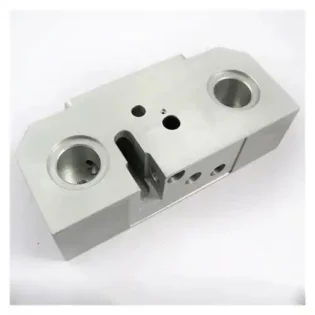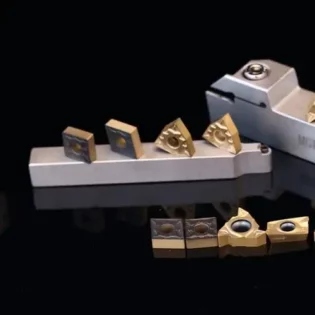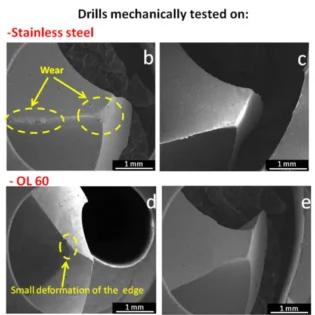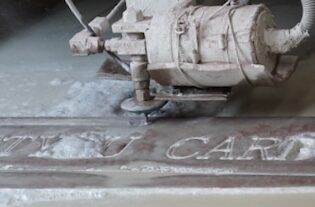Cause of wear on Cutting tool include the following ones:
Cutting tool materials
Tool material is the fundamental factor to determine the cutting performance of the tool, which has a great influence on the machining efficiency, machining quality, machining cost and tool durability. The harder the tool material is, the better the wear resistance, the higher the hardness, the lower the impact toughness and the more brittle the material is. Hardness and toughness are a pair of contradictions and a key to overcome for tool materials. For graphite cutting tools, the common TiAlN coating can choose the materials with relatively better toughness, that is, the cobalt content is slightly higher; for diamond coated graphite cutting tools, the hardness is relatively better, that is, the cobalt content is slightly lower.
Geometric Angle of Tool
Choosing the appropriate geometric angle of graphite cutter can help to reduce the vibration of the cutter. Conversely, graphite workpiece is not easy to collapse.
1. When graphite is machined with negative rake angle, tool edge strength is better, impact resistance and friction resistance are better. With the decrease of absolute value of negative rake angle, the wear area of flank changes little, but the overall trend is decreasing. When graphite is machined with positive rake angle, the tool becomes sharper with the increase of rake angle, but the strength of tool edge is reduced. Weakening, on the contrary, leads to worsening of flank wear. When the negative rake angle is machined, the cutting resistance is large and the cutting vibration is increased. When the large positive rake angle is machined, the tool wear is serious and the cutting vibration is large. Generally, the tool with smaller rake angle or negative rake angle should be selected for rough machining.
2. If the back angle increases, the strength of the tool edge decreases and the wear area of the flank increases gradually. When the tool’s back angle is too large, the cutting vibration is strengthened. The smaller the rear angle is, the longer the friction contact length between the elastic restoring layer and the flank is. It is one of the direct causes of the wear of the cutting edge and the flank. In this sense, increasing the rear angle can reduce friction and improve the machined surface quality and tool life.
3. When the helix angle is small, the cutting edge length of graphite workpiece cut into at the same cutting edge is the longest, the cutting resistance is the greatest, and the cutting impact force is the greatest, so the tool wear, milling force and cutting vibration are the greatest. When the helix angle is larger, the direction of the milling resultant force deviates from the workpiece surface to a large extent, and the cutting impact caused by the disintegration of graphite material increases, so the tool wear, milling force and cutting vibration also increase. Therefore, the influence of tool angle change on tool wear, milling force and cutting vibration is caused by the combination of front angle, rear angle and helix angle, so more attention must be paid to the selection.
Through a large number of scientific tests on the processing characteristics of graphite materials, PARA tool optimizes the geometric angle of the relevant tools, which greatly improves the overall cutting performance of the tool.
Coating of Cutting Tools
Diamond coated cutting tools have the advantages of high hardness, good wear resistance and low friction coefficient. At present, diamond coated cutting tools are the best choice for graphite processing, and can best reflect the superior performance of graphite cutting tools. The advantages of diamond coated carbide cutting tools are the combination of hardness of natural diamond and strength of cemented carbide. And fracture toughness; but the technology of diamond coating in China is still in its infancy, and the investment of cost is very large, so the development of diamond coating will not be too great, but we can optimize the angle of tools, material selection and other aspects and improve the structure of common coating on the basis of common tools, in a certain process. Degree can be used in graphite processing.
The geometric angle of diamond coated cutter is essentially different from that of common coated cutter, so when designing diamond coated cutter, due to the particularity of graphite processing, its geometric angle can be enlarged appropriately, the volume cutting groove will be enlarged, and the wear resistance of cutter edge will not be reduced. For ordinary TiAlN coating, though it is better than uncoated one. Compared with diamond coating, the geometric angle of graphite cutting tool should be appropriately reduced to increase its wear resistance.
Tool surface treatment technology has also made new development. Mobile spinach has released the latest foreign news: using solid nano-structure boron atoms to modify the tool surface can greatly improve tool life.
For diamond coating, many coating companies in the world have invested a lot of manpower and material resources to research and develop related coating technology, but up to now, mature and economic coating companies abroad are limited to Europe; PARA, as an excellent graphite processing tool, also uses the most advanced coating technology in the world. Tool surface treatment to ensure the processing life, while ensuring the economic and practical tool.
Strengthening of Tool Edge
Tool edge passivation technology is a very important problem which has not been paid attention to universally. After grinding with diamond grinding wheel, there are different degrees of micro-notches in the carbide tool edge (i.e. micro-breaking edge and saw edge). The performance and stability of graphite high-speed cutting tools require higher requirements, especially the diamond coated tools must be passivated before coating, in order to ensure the firmness and service life of the coating. The purpose of tool passivation is to solve the defects of the micro-notches on the cutting edge after grinding, to reduce or eliminate the edge value, and to achieve the goal of smoothness, robustness and durability.
Processing conditions
Choosing appropriate processing conditions has a considerable impact on tool life.
1. Cutting mode (forward milling and reverse milling), the cutting vibration of forward milling is less than that of reverse milling. The cutter cut-in thickness decreases from the maximum to zero in downmilling, and there will be no bullet-cutter phenomenon caused by cutting no chips after cutter cut-in. The rigidity of the process system is good and the cutting vibration is small. In reverse milling, the cutter cut-in thickness increases from zero to the maximum, and the cutter cut-in thickness will be uniform on the surface of the workpiece at the initial stage because of the thin cutting thickness. Section path, if the edge encounters hard particles in graphite material or chip particles remaining on the surface of the workpiece, it will cause the bullet cutter or chatter of the cutter, so the cutting vibration of reverse milling is large.
2. Blowing (or vacuum) and impregnating EDM processing, timely cleaning of graphite dust on workpiece surface, is conducive to reducing tool secondary wear, prolonging tool life, reducing the impact of graphite dust on machine tool screw and guide rail;
3. Choose suitable high speed and corresponding large feed.
Summarize the above points. Tool material, geometric angle, coating, edge strengthening and machining conditions play different roles in tool life, which are indispensable and complementary. A good graphite cutter should have a smooth graphite powder chip removal groove, long service life, deep engraving processing, and can save processing costs.

Improvement method
1. Edge wear.
Improvements: increase feed rate; reduce cutting speed; use more wear-resistant blade materials; use coated blades.
2. Disintegration.
Improvement methods: use more tough material; use edge-strengthened blades; check the rigidity of the process system; increase the main deflection angle.
3. Thermal deformation.
Improvements: reduce cutting speed; reduce feed; reduce cutting depth; use more hot and hard materials.
4. Deep cutting damage.
Improvement methods: changing the main deflection angle; edge strengthening; changing the blade material.
5. Hot crack.
Improvements: correct use of coolant; reduce cutting speed; reduce feed; use coated blades.
6. Scrap accumulation.
Improvement: Increase cutting speed; Increase feed; Use coated blade or cermet blade; Use coolant; Make the edge sharper.
7. Crescent crater wear.
Improvements: reduce cutting speed; reduce feed; use coated blades or cermet blades; use coolant.
8. Fracture.
Improvement: use more tough material or groove; reduce feed; reduce cutting depth; check the rigidity of the process system.
Note: When the wear of the flank is up to 0.7 mm, the blade edge should be replaced; the maximum wear is 0.04 mm in finishing.









